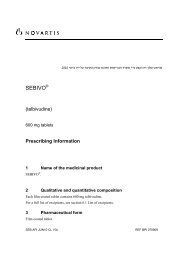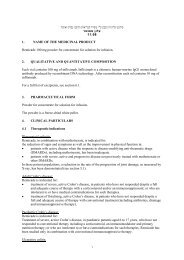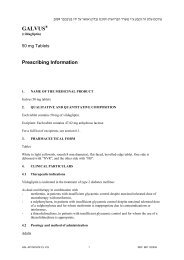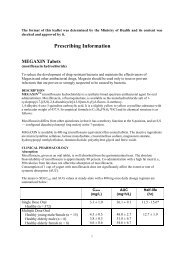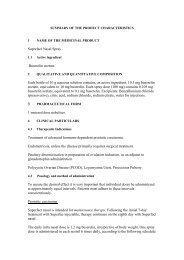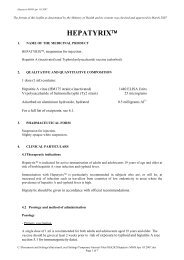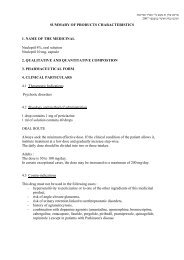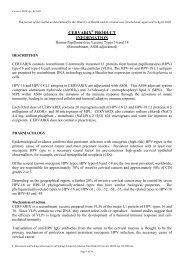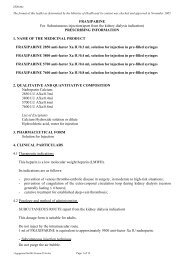SUMMARY OF PRODUCT CHARACTERISTICS
SUMMARY OF PRODUCT CHARACTERISTICS
SUMMARY OF PRODUCT CHARACTERISTICS
You also want an ePaper? Increase the reach of your titles
YUMPU automatically turns print PDFs into web optimized ePapers that Google loves.
The format of this leaflet was determined by the Ministry of Health and its content was<br />
checked and approved on May 2009<br />
<strong>SUMMARY</strong> <strong>OF</strong> <strong>PRODUCT</strong> <strong>CHARACTERISTICS</strong><br />
1. NAME <strong>OF</strong> THE MEDICINAL <strong>PRODUCT</strong><br />
IXEL 50 mg, hard capsule<br />
IXEL 25mg, hard capsule<br />
2. QUALITATIVE AND QUANTITATIVE COMPOSITION<br />
IXEL 50mg:<br />
Milnacipran hydrochloride…………………………………………………….50.00 mg<br />
Quantity equivalent to Milnacipran free base…………………………………43.55 mg<br />
IXEL 25mg:<br />
Milnacipran hydrochloride…………………………………………………….25.00 mg<br />
Quantity equivalent to Milnacipran free base…………………………………21.77 mg<br />
For excipients, see 6.1<br />
3. PHARMACEUTICAL FORM<br />
New proposal dated October 200629/10/2009<br />
For one hard capsule<br />
Hard capsule.<br />
Pink cap and body, imprinted with “Ixel 25”.<br />
Pink cap and rust-coloured body, imprinted with « Ixel 50 ».<br />
4. CLINICAL PARTICULARS<br />
4.1. Therapeutic Indications<br />
Treatment of major depressive episodes in adults.<br />
4.2 Posology and Method of Administration<br />
Dosage and Method of Administration<br />
Recommended dosage is 100 mg a day in two divided 50 mg doses, 1 capsule morning and<br />
evening preferably during meals.<br />
In this case, use the 50 mg capsules.<br />
In the elderly, dosage adjustment is not necessary as long as renal function is normal.<br />
(see Pharmacokinetic properties).<br />
In patients with renal failure, dosage adjustment is necessary.<br />
The recommended dosage is reduced to 50 or 25 mg depending on the degree of alteration of<br />
renal function (see Pharmacokinetic properties).<br />
In this case, use 25 mg capsules.<br />
The following dosage adjustment is recommended:<br />
1
Creatinine clearance (Clcr)<br />
(ml/min)<br />
Dosage /24 h<br />
Clcr ≥60 50 mg x 2<br />
60 > Clcr ≥30 25 mg x 2<br />
30 > Clcr ≥10 25 mg<br />
Duration of treatment:<br />
Treatment with antidepressants is symptomatic.<br />
As with all antidepressants, the efficacy of Milnacipran only becomes apparent after a certain<br />
delay which can vary from 1 to 3 weeks.<br />
For one episode treatment should last for several months (usually about 6 months) in order to<br />
prevent relapses.<br />
Milnacipran treatment should be discontinued gradually.<br />
Associated psychotropic treatments:<br />
Concomitant prescription of a sedative or anxiolytic medication can be useful at the start of<br />
treatment to prevent occurrence or worsening of symptoms of anxiety.<br />
But anxiolytics do not necessarily protect the patient from suicide attempts.<br />
4.3 Contra-indications<br />
This medication should never be used in the following cases:<br />
- Known hypersensitivity to Milnacipran;<br />
- Association with non-selective MAO inhibitors, B selective MAO inhibitors, digitalis and<br />
5 HT1D agonists (sumatriptan...) (See Interactions with other medicaments);<br />
- Lactation.<br />
Generally, this medication should not be used in the following cases:<br />
- In association with epinephrine and norepinephrine by parenteral route, clonidine and<br />
related compounds and A selective MAO inhibitors, (see Precautions for use and<br />
Interactions with other medicaments);<br />
- Prostatic hypertrophy and other genito-urinary disorders;<br />
- Pregnancy (see Pregnancy and lactation).<br />
4.4. Special warnings and special precautions for use<br />
Warnings<br />
As in treatment with other antidepressants, suicide attempts in patients suffering from<br />
depression persist at the start of treatment, since the effect on psychomotor inhibition may<br />
precede the antidepressant action of this medication.<br />
Use in children and adolescents under 18 years of age<br />
Milnacipran is not recommended in the treatment of children and adolescents under the age<br />
of 18 years. Suicide-related behaviours (suicide attempt and suicidal thoughts), and hostility<br />
(predominantly aggression, oppositional behaviour and anger) were more frequently observed<br />
in clinical trials among children and adolescents treated with antidepressants compared to<br />
those treated with placebo. If, based on clinical need, a decision to treat is nevertheless taken,<br />
the patient should be carefully monitored for the appearance of suicidal symptoms. In<br />
addition, long-term safety data in children and adolescents concerning growth, maturation and<br />
cognitive and behavioural development are lacking.<br />
Precautions for Use<br />
New proposal dated October 200629/10/2009<br />
2
3<br />
Patients with insomnia or nervousness at the beginning of treatment may require transient<br />
symptomatic therapy.<br />
If a patient experiences a switch into frank mania, treatment with Milnacipran should be<br />
discontinued and in most cases a sedative antipsychotic agent prescribed.<br />
Although no interaction with alcohol has been evidenced, it is recommended to avoid alcohol<br />
intake, just as with any psychotropic medication.<br />
Systemic body exposure to Milnacipran is increased by 20% when combined with<br />
levomepromazine in healthy volunteers. A higher increase may be suspected in elderly or<br />
renal impairment patients if the drugs are to be combined.<br />
Milnacipran should be prescribed with caution in the following cases:<br />
-In patients with renal failure:<br />
Dosage may have to be reduced because of prolongation of elimination half-life (see Posology<br />
and method of administration);<br />
-Iin patients with a history of difficult passage of urine, notably in patients with prostatic<br />
hypertrophy and other genito-urinary disorders. Because of the noradrenergic component of<br />
the mechanism of Milnacipran action, a monitoring of the miction disorders is necessary;<br />
-In patients with hypertension or cardiac disease:<br />
It is recommended to increase the clinical monitoring, since Milnacipran can slightly increase<br />
heart rate in some patients;<br />
-In patients with narrow-angle glaucoma;<br />
-In patients with epilepsy or with a history of epilepsy : Milnacipran should be used with<br />
caution and should be discontinued in any patient developing a seizure.<br />
There have been cases of hyponatremia in patients receiving serotonin re-uptake inhibitors,<br />
possibly due to the syndrome of inappropriate antidiuretic hormone secretion. Caution is<br />
advised in elderly, patients taking diuretics or other treatment known to induce hyponatremia,<br />
patients with cirrhosis or malnutrition.<br />
Cases of haemorrhages, sometimes serious, have been reported with the use of serotonin reuptake<br />
inhibitors. Caution should be exercised in patients concomitantly treated with oral<br />
anticoagulants, drugs which have an effect on platelet function, e.g. NSAIDs and aspirin, or<br />
other drugs that may increase the risk of bleeding. Caution is also required in patients with<br />
previous bleeding abnormalities.<br />
4.5. Interactions with other medication and other forms of interaction<br />
COMBINATIONS CONTRA-INDICATED:<br />
• With non selective MAO inhibitors (iproniazide)<br />
Risk of a serotoninergic syndrome* (see below).<br />
There should be an interval of two weeks between the end of treatment with a MAO inhibitor<br />
and the beginning of treatment with Milnacipran, and at least one week between the end of<br />
treatment with Milnacipran and the beginning of treatment with a MAO inhibitor.<br />
*Serotoninergic syndrome:<br />
Serotonin syndrome<br />
Caution is advisable if IXEL is used concomitantly with medicinal products with serotonergic<br />
effects such as sumatriptan or other triptans, tramadol and tryptophan.<br />
In rare cases, serotonin syndrome has been reported in patients using SSRIs/ SNRI s<br />
concomitantly with serotonergic medicinal products. A combination of symptoms, such as<br />
New proposal dated October 200629/10/2009
agitation, tremor, myoclonus and hyperthermia may indicate the development of this<br />
condition. If this occurs treatment with the SSRI/ SNRI and the serotonergic medicinal<br />
product should be discontinued immediately and symptomatic treatment initiated.<br />
Some cases of drug overdosage or certain medications (lithium) can cause a serotoninergic<br />
syndrome requiring immediately termination of therapy with Milnacipran.<br />
The serotoninergic syndrome consists of the simultaneous or sequential development<br />
(sometimes sudden) of a constellation of symptoms which may require hospitalization or even<br />
cause death.<br />
The following symptoms may occur:<br />
- Psychiatric (agitation, confusion, hypomania, possibly coma),<br />
- Motor (myoclonus, tremor, hyperreflexia, rigidity, hyperactivity),<br />
- Vegetative (hypo-or hypertension, tachycardia, chills, hyperthermia, sweating),<br />
- Gastrointestinal (diarrhea).<br />
.<br />
Strict compliance with the dosage prescribed is an essential factor in preventing the onset of<br />
this syndrome.<br />
• With B Selective MAO inhibitors (selegiline)<br />
Risk of paroxystic hypertension.<br />
There should be an interval of two weeks between the end of treatment with a B selective-<br />
MAO inhibitor and the beginning of treatment with Milnacipran and at least one week<br />
between the end of treatment with Milnacipran and the beginning of treatment with a B-MAO<br />
inhibitor.<br />
• With 5 HT1D agonists (sumatriptan...)<br />
By extrapolation with selective inhibitors of serotonin re-uptake.<br />
Risk of hypertension, coronary artery vasoconstriction by additive serotoninergic effects.<br />
Wait one week between the end of treatment with Milnacipran and the beginning of treatment<br />
with 5 HT1D agonists.<br />
• With digitalis (digoxin...)<br />
Risk of potentiation of haemodynamic effects, in particular by parenteral route.<br />
UNADVISABLE COMBINATIONS<br />
• With epinephrine, norepinephrine (alpha and beta sympathomimetics)<br />
In case of systemic action by parenteral route.<br />
Paroxystic hypertension with possible arrhythmia (inhibition of entry of epinephrine or<br />
norepinephrine into the sympathetic nerve fiber).<br />
• With clonidine and related compounds (reported with desipramine and imipramine)<br />
Inhibition of clonidine's antihypertensive effect (antagonism with adrenergic receptors).<br />
• With A selective MAO inhibitors (moclobemide, toloxatone)<br />
Risk of development of a serotoninergic syndrome* (see above).<br />
If this combination cannot be avoided, monitor patient very carefully.<br />
Initiate such a combination with the lowest recommended dose.<br />
ASSOCIATIONS REQUIRING PRECAUTIONS FOR USE:<br />
New proposal dated October 200629/10/2009<br />
4
5<br />
• With epinephrine, norepinephrine (alpha and beta sympathomimetics)<br />
When hemostatic action by subcutaneous or gingival injection is sought:<br />
Paroxystic hypertension with possible arrhythmia (inhibition of entry of epinephrine or<br />
norepinephrine into the sympathetic nerve fiber).<br />
Limit intake, for example, to less than 0.1mg epinephrine in 10 minutes or 0.3 mg in an hour,<br />
in adults.<br />
• With Lithium<br />
Risk of development of serotoninergic syndrome* (see above).<br />
Perform regular clinical monitoring of the patient.<br />
4.6. Pregnancy and lactation<br />
There are no adequate data from the use of Milnacipran in pregnant women.<br />
Animal studies do not indicate direct or indirect harmfull effects with respects to pregnancy,<br />
embryonal/foetal development, parturition or postnatal development (see Preclinical safety<br />
data).<br />
Neonatal risk after pregnancy exposure with serotonin re-uptake inhibitors have been reported<br />
and may be related to either withdrawal syndrome or serotonin toxicity: tachypnea, feeding<br />
difficulties, tremors, hypertonicity or hypotonia, sleeping disorders, hyperexcitability or more<br />
rarely longlasting crying. All these signs appear in the first days of life and are generally of<br />
short duration and not severe.<br />
Consequently, as a precautionary measure, it is preferable not to administer Milnacipran<br />
during pregnancy.<br />
Because small amounts of Milnacipran are excreted in breast-milk, breast-feeding is<br />
contraindicated.<br />
4.7. Effects on ability to drive and use machines<br />
Although no alterations in cognitive or psychomotor functions have been observed in healthy<br />
volunteers, this medication can diminish mental and physical capacities necessary to perform<br />
certain dangerous tasks, such as operating machinery or driving motor vehicles.<br />
4.8. Undesirable effects<br />
The undesirable effects observed during treatment with Milnacipran are observed mainly<br />
during the first week or first two weeks of treatment and subsequently regress, concomitantly<br />
with improvement in the depressive episode.<br />
Such effects generally are mild and only rarely result in discontinuation of therapy.<br />
The most commonly reported adverse events with single-drug therapy or in case of<br />
combination with other psychotropic agents during clinical trials and occurring less<br />
commonly in patients treated with placebo are vertigo, excessive sweating, anxiety, hot flush,<br />
and dysuria.<br />
Less frequent adverse events reported are nausea, vomiting, dry mouth, constipation, tremor,<br />
palpitations, agitation, headache, urticaria, rash, sometimes maculo-papular, erythematous and<br />
pruritus.<br />
It is to be noted that patients with a history of cardiovascular disorder or concomitant cardiac<br />
medication might have a higher incidence of cardiovascular adverse events (e.g.,<br />
hypertension, hypotension, postural hypotension, tachycardia and palpitations).<br />
In rare instances, the following can occur:<br />
New proposal dated October 200629/10/2009
6<br />
- A serotoninergic syndrome, when combined with other agents (see Interactions with<br />
other medicaments);<br />
- Moderate elevation of transaminases; Cases of cytolytic hepatitis have also been<br />
reported with Milnacipran during post-marketing.<br />
- Urinary retention (cf precautions for use);<br />
- Convulsions particularly in patients with past history of epilepsy (cf precautions for<br />
use);<br />
- Testicular pain, ejaculation disorders.<br />
In exceptional instances, the following can occur :<br />
- Hyponatremia (cf precautions for use);<br />
- Ecchymosis and other cutaneous or mucous bleedings (cf precautions for use).<br />
Furthermore, some adverse events are related to the very nature of the depressive illness:<br />
- Elimination of psychomotor inhibition, with suicidal risk,<br />
- Mood switch, with episodes of mania,<br />
- Reactivation of a delirium in psychotic patients,<br />
- Paroxystic symptoms of anxiety (with psychostimulant antidepressants).<br />
4.9. Overdose<br />
A few cases of overdosage have been observed with Milnacipran.<br />
With high doses, the emetic effect can considerably limit the risk of overdosage.<br />
With a 200 mg dose, the following events have commonly been observed (> 10%): nausea,<br />
excessive sweating, and constipation.<br />
With doses of 800 mg to 1 g in single-drug therapy, the main symptoms observed are<br />
vomiting, respiratory difficulties (apneic spells), and tachycardia.<br />
After a massive dose (1.9 g to 2.8 g), in combination with other drugs (in particular,<br />
benzodiazepines), the following additional symptoms occur: drowsiness, hypercapnia and<br />
alterations of consciousness.<br />
No cardiac toxicity has been reported.<br />
Treatment of overdosage:<br />
There is no specific antidote for Milnacipran.<br />
Treatment is symptomatic, with gastric lavage and activated charcoal as soon as possible after<br />
oral ingestion. Medical monitoring should be continued for at least 24 hours.<br />
5. PHARMACOLOGICAL PROPERTIES<br />
5.1. Pharmacodynamic properties<br />
ANTIDEPRESSANT.<br />
OTHER ANTIDEPRESSANTS<br />
ATC class : N06A X17<br />
Milnacipran is a dual inhibitor of (5 HT) serotonin and norephinephrine re-uptake.<br />
Unlike most tricylic antidepressants, Milnacipran has no affinity for α 1 adrenergic or<br />
H 1 histaminergic receptors.<br />
Binding experiments suggest that Milnacipran has no significant affinity for cholinergic<br />
(muscarinic) receptors.<br />
Furthermore, Milnacipran also has no affinity for D 1 and D 2 dopaminergic receptors,<br />
benzodiazepine and opioid receptors.<br />
New proposal dated October 200629/10/2009
7<br />
In humans:<br />
- At therapeutic doses, plasma concentrations observed are consistently at levels<br />
corresponding to 50% to 90% inhibition of norepinephrine and serotonin re-uptake.<br />
- The pharmacologic effects observed in the gastro-intestinal and genito-urinary systems<br />
appear to be related to inhibition of norepinephrine re-uptake which can exert an<br />
antagonistic effect on acetylcholine (indirect anticholinergic effect).<br />
- Milnacipran does not induce any significant clinical change in cardiac repolarization or<br />
conduction.<br />
- It does not affect cognitive function and has little sedative effect.<br />
- Sleep disturbances improve in depressive patients treated with Milnacipran.<br />
The latency time to fall asleep is decreased and also the number of nightly awakenings<br />
and the latency for onset of paradoxal sleep are increased.<br />
Total duration of sleep is increased.<br />
The efficacy of Milnacipran was compared to that of SSRI and tricyclics and found to be less<br />
than that of clomipramine.<br />
5.2. Pharmacokinetic properties<br />
Absorption<br />
Milnacipran is well-absorbed after oral administration.<br />
Bioavailability is about 85%.<br />
It is unchanged by food intake.<br />
Peak plasma concentrations (Cmax) are reached approximately two hours (Tmax) after an<br />
oral dose.<br />
This concentration is about 120 ng/ml after a single 50 mg dose.<br />
Concentrations are dose-related up to 200 mg per administration.<br />
After repeated dose administration, the steady state is reached within 2 to 3 days with an<br />
increase in concentration of about 70% to 100% compared to a single dose<br />
(Cmax: 216 ng/ml).<br />
Inter-individual variability is low.<br />
Distribution<br />
Protein binding is low (13%) and not saturable.<br />
The volume of distribution of Milnacipran is about 5 l/kg with a total clearance of about<br />
40 l/hour.<br />
Renal and non-renal clearances are equivalent.<br />
Biotransformation<br />
Milnacipran is metabolized mainly by glucuronic acid conjugation.<br />
Active metabolites have been found at very low levels without clinical relevance.<br />
Elimination<br />
Plasma elimination half-life is about 8 hours.<br />
Elimination occurs mainly via the kidney (90% of the dose administered) with tubular<br />
secretion of the product in unchanged form.<br />
After repeated doses, Milnacipran is totally eliminated two to three days after termination of<br />
therapy.<br />
High-risk Patients<br />
Patients with impaired liver function<br />
New proposal dated October 200629/10/2009
8<br />
Impairment of hepatic function does not cause any significant changes in Milnacipran's<br />
pharmacokinetic parameters.<br />
Patients with renal failure<br />
In case of renal failure, Milnacipran is eliminated more slowly, in proportion to the degree of<br />
renal function alteration (see Dosage and method of administration).<br />
Patients over age 65 years<br />
Milnacipran's pharmacokinetic parameters are not significantly altered in the elderly.<br />
However, physiological alteration of renal function should be taken into account (see Dosage<br />
and method of administration).<br />
5.3. Preclinical safety data<br />
With repeated dose administration, the liver is the target organ in all animal species studied.<br />
The first effects develop with high doses, about 10 times the dose used in clinical practice and<br />
are reversible.<br />
Milnacipran is neither mutagenic nor carcinogenic.<br />
Experimental data do not reveal any teratogenic or foetotoxic potential of Milnacipran.<br />
6. PHARMACEUTICAL PARTICULARS<br />
6.1. List of excipients<br />
Calcium hydrogen phosphate dihydrate, carmellose calcium, povidone K 30, anhydrous<br />
colloidal silica, magnesium stearate, talc.<br />
Composition of the hard capsule shell:<br />
• IXEL 50 mg<br />
Cap (pink): titanium dioxide (E171), red iron oxide (E172), yellow iron oxide (E172), gelatin.<br />
Body (rust-coloured): titanium dioxide (E171), red iron oxide (E172), yellow iron oxide<br />
(E172), gelatin.<br />
• IXEL 25 mg<br />
Cap and Body (pink): titanium dioxide (E171), red iron oxide (E172), yellow iron oxide<br />
(E172), gelatin.<br />
6.2. Incompatibilities<br />
Not applicable<br />
6.3. Shelf-life<br />
3 years<br />
6.4. Special precautions for storage<br />
Do not store above 30°C.<br />
6.5. Nature and content of the container<br />
14 capsules in blister (PVC-Aluminium)<br />
28 capsules in blister (PVC-Aluminium)<br />
56 capsules in blister (PVC-Aluminium)<br />
112 capsules in blister (PVC-Aluminium)<br />
New proposal dated October 200629/10/2009
Not all pack sizes may be marketed.<br />
Manufacturer :<br />
PIERRE FABRE MEDICAMENT <strong>PRODUCT</strong>ION<br />
45, PLACE ABEL GANCE<br />
92100 BOULOGNE<br />
FRANCE<br />
Importer: Mediline LTD<br />
22 Ben Gurion st, Hetzlia<br />
New proposal dated October 200629/10/2009<br />
9



